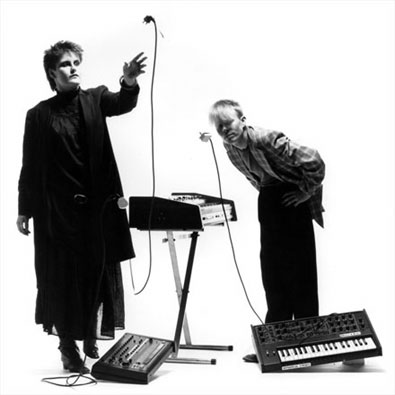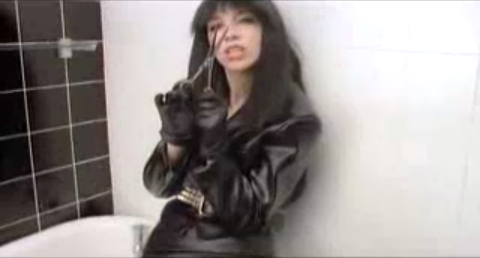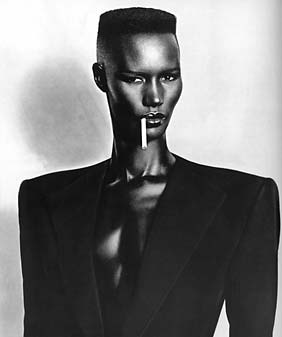Posts Tagged Grace Jones
The Cold-Warm Effect
Posted by Gavin Bradley in Production, Singing, Writing on June 18, 2009
After the sound of monophonic synthesizers, played by hand one note at a time, became commonplace on progressive rock recordings in the early 70s…
After people got used to hearing tapestries of synths triggered like clockwork by unfeeling sequencers and arpeggiators in the experiments of Kraftwerk through the mid 70s…
And after producer Giorgio Moroder pulled late-70s disco into the future by placing Donna Summer’s operetics over a pulsing synthetic backdrop on ‘I Feel Love’…
…Alison Moyet belted ‘Goodbye 70s’ over Vince Clark’s minimal synth and drum machine programming on Yaz’s 1981 debut album ‘Upstairs At Eric’s’.
Clark, the keyboard player and chief songwriter for a fledgling Depeche Mode, left the band after their debut album and formed Yaz (known in the UK as Yazoo). Clark’s working relationship with Moyet also imploded early on, leaving just two beautifully crafted Yaz albums. The detached lyrical attitude was new wave and the melodies were pure pop, but the juxtaposition of the warm human soul in Moyet’s ferociously large voice over top of Clark’s frigid production was a new level of what I call ‘cold-warm’ production.
‘Midnight’ is a great example of this style. After a naturally-paced acapella intro, the synth sequence begins without drama or fanfare. Emotionless and ruthlessly precise, it’s there solely to do the job of defining a framework of chords and rhythm under her voice. Her delivery is suddenly recontextualized: because the backdrop is icy cold, the heat of human breath against it is that much more apparent.
After Yaz, Moyet began a successful solo career and Clark formed Erasure with Andy Bell–whose vocal tone, it has been noted, is curiously similar to Moyet’s.
Enter Eurythmics. Dave Stewart and Annie Lennox had been making music together for some time, first in rock band The Tourists and then as Eurythmics, releasing their experimental but mostly organic (ie non-electronic) debut album ‘In The Garden’ in 1981.
But then they clued in on where Yaz, and other UK synth-based bands like The Human League and Heaven 17 were going and jumped in on their seminal ‘Sweet Dreams (Are Made Of This)’ album in 1983.
The liner notes on the 2005 reissues of the Eurythmics’ catalog discussed which drum machines and synths had been used, and also revealed that organic sounds–like drumming on glass bottles–were routinely weaved in. However, these were treated with effects so as to be camouflaged as part of the cold electronics. A manifesto of the pair’s directives was written on the wall of their studio, including the phrases ‘Tamla Motown,’ ‘Electronica’ and ‘Coldness’. So there it is: soul on ice.
On their best work–the fully electronic ‘Sweet Dreams’, ‘Touch’ and ‘Savage’ albums–Lennox’s soulful voice is generally the solitary human element sitting on top of the coldness. She even sonically evokes the visual of her warm breath meeting wintery cold in her trademark practice of peppering vocal performances with gutteral stabs of exhalation. Very occasionally another warm melodic element is chosen to create that same contrast against the pings and bleeps: the long trumpet solo on ‘The Walk’ and the violin lines of the British Philharmonic Orchestra on ‘Here Comes The Rain Again’.
‘Love Is A Stranger’ is a 3-minute pop song with a perfect balance of soul and circuitry.
Lennox pushed her experimentation with coldness further by developing a suitably cold image. Often labeled androgynous, I believe her main character, sporting an orange crew-cut, would be more accurately described as inhabiting a deadened sexuality. After having established that baseline, she was then in a position to play with the hypermasculine (dressing up as Elvis in the video for ‘Who’s That Girl’) or the hyperfeminine (her female character in the same video, or the split-personality cougar depicted on the ‘Savage’ concept album) as a way to critique, humorously, the traditionally accepted extremes of gender.
She also brought a detached, frigid air to many of her lyrics. On ‘Regrets’ she plays a bloodless character listing the chilling powers available to her: “I’ve got a dangerous nature, and my fist collides with your furniture…I’ve got a razor blade smile…fifteen senses are on my palette…I’m an electric wire and I’m stuck inside your head.” After establishing a consistent lack of emotion, lyrically, the slightest hint of tenderness in her lyrics would be magnified tenfold.
It must be said–because it’s not mentioned very often–that much of the groundwork for Lennox’ success was laid by Grace Jones. In fact Jones’ vocal licks and delivery, her ruthless lyrical style and her arty experimentation with androgyny right down to the signature crew cut were clearly recycled by Lennox in the early years of Eurythmics. What Jones lacked was commercial hooks in the songs, and what was special about the Eurythmics was the starkness of the electronic backdrop that Dave Stewart provided, which in my view couldn’t have more perfectly showcased the warmth of the human voice.



